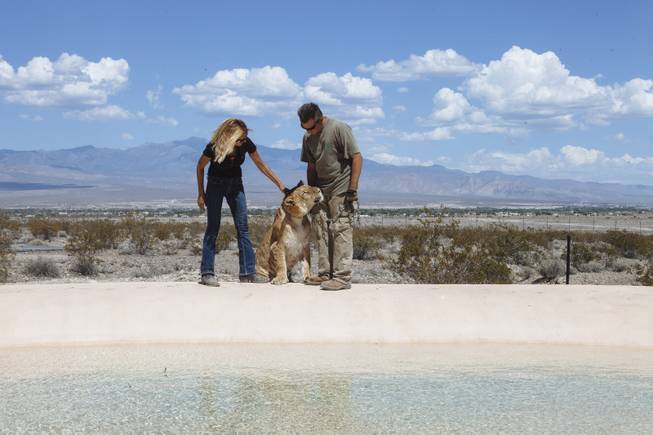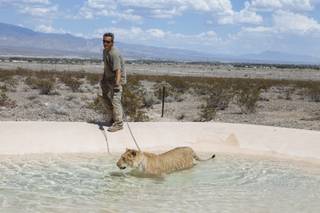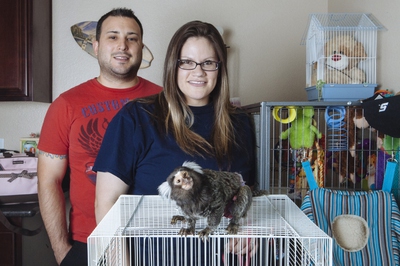
Zuzana Kukol and Scott Shoemaker, founders of Rexano (Responsible Exotic Animal Ownership), engage with their animals Friday, July 17, 2015, in Pahrump.
Sunday, Dec. 13, 2015 | 2 a.m.
In most states, you can’t keep a tiger, a monkey or even a hedgehog at home.
In Nevada, depending on where you live and whether you’re willing to navigate a little red tape, you can.
The state regulates only the possession of indigenous wildlife, not exotic animals, or species found elsewhere. Although Nevada lawmakers in the 2013 and 2015 legislative sessions introduced bills to regulate the possession of exotic animals, neither bill made it to a vote.
That means, at least for now, exotic animal regulation is left up to cities and counties, a patchwork approach that leaves many owners confused and some species in a gray area.
Zuzana Kukol & Scott Shoemaker, large cat caretakers
Red- and brown-streaked mountains tower above a sprawling 10-acre property at the end of a long dirt road on the outskirts of Pahrump. There’s not much there. It’s intentionally out of the way, surrounded mostly by federal land.
If Zuzana Kukol and Scott Shoemaker didn’t invite you onto their property — and if not for the 8-foot electric fence that surrounds it — you might not know 12 big cats call it home, too.
Kukol and Shoemaker are practiced feline owners. They know their cats. They know when something’s wrong.
Kukol grew up in a small apartment in eastern Europe but spent much of her childhood riding horses.
“I always wanted to be a veterinarian, but when I came to this country, I didn’t speak any English,” said Kukol, who came to the United States as a political refugee.
After living in California and Washington, Kukol bought the land near the outskirts of Pahrump in 2000. Shoemaker, a retired defense contractor, joined her in 2004. Although they’re now retired, taking care of their cats and 21 canines — many of which are full or part wolf — is a full-time job.
“I’m probably working harder than I was in the military,” Shoemaker said.
Kukol and Shoemaker build everything by hand. They save money that way, because they pay for everything out of pocket. The animals’ enclosures are roomy, filled with plants, toys, platforms for jumping and pools for swimming.
The couple’s days begin early, checking on all the animals’ water and deciding what needs to be cleaned. The lions and tigers eat about 10 pounds per day, while the bobcat eats about 4 pounds. The animals are rotated between enclosures every few days to keep them entertained.
“One misconception is that we do it for ego,” Shoemaker said. “Many people get into it for ego, but you don’t stay in it for ego.”
The bond between Kukol and Shoemaker and the animals is clear. Their interactions are warm and familiar. Pebbles, an orange tiger, greets Kukol by rubbing up against the fence and making a chuffing sound — a breathy noise that’s big-cat speak for “hello,” like a house cat’s purr. Kukol returns the noise as she strokes Pebbles’ cheek.
There’s also Hope the liger; Elvis the white tiger; Frosty the snow white tiger; Princess the golden tabby tiger; Isis the ocelot; Tiny the serval; Luna the bobcat; two cougars, Coogie and Katz; and two lions, Bam Bam and Libby.
Many of the animals lived elsewhere in Nevada but were unable to be kept by their owners. Kukol and Shoemaker also recently adopted a wallaroo, a wallaby, a lemur and four coatimundi.
“The majority of people are misinformed and think these animals are from the wild,” Kukol said. “Our cats are captive bred. They’re more American than me. If you left them in the wild, they would die.”
The couple runs Rexano, a nonprofit organization that supports the rights of people to keep wild and exotic animals privately. But Kukol and Shoemaker also support a reasonable amount of regulation, such as by the USDA, to ensure animals are cared for safely and humanely.
“People think that we’re keeping them in small cages in our backyard, but we don’t,” Kukol said. “Cats are noisy. You can’t hide them. People actually get concerned when Bam Bam doesn’t roar.”
The cats are held under a permit from Nye County. Officials inspect the property once a year and enforce regulations about how the animals must be kept. Though they aren’t USDA-regulated, Kukol and Shoemaker may apply for a license to exhibit animals in the future so they can accept occasional requests to take commercial photos of their pets, Kukol said.
Even if they did receive a USDA license, the couple has no immediate plans to open to the public.
“That’s why I came out here,” Kukol said. “I wanted total privacy near the mountains.”
Jon, the monkey guru
Gemma blinks with wide eyes as she sits on the shoulder of her owner, Jon, studying her surroundings.
Jon, who asked to be identified only by his first name, is a marmoset owner in Clark County. Although he operates his marmoset-breeding business legally with a USDA license, local ordinances are unclear about whether marmosets can be kept privately. He said requests for clarification from local government officials have gone unanswered.
Jon and his wife bought Gemma after meeting a marmoset breeder in December 2013 in Florida. Gemma arrived in January 2014 when she was a baby.
Raising Gemma, now 2 and fully grown, has required a significant emotional and financial commitment. With any marmoset, the three most important needs are love, attention and discipline, Jon said.
“Gemma is like our daughter,” he said. “We take her a lot of places — to the park, to PetSmart. We take her out a lot to try to educate people about marmosets.”
After Gemma settled in, Jon and his wife decided to try marmoset breeding and bought an older pair named Luke and Leia. Jon now runs “The Monkey Guru,” breeding marmosets out of his house.
Luke and Leia have to be cared for slightly differently than Gemma, because marmoset breeding is regulated by the USDA and their enclosure is subject to routine inspections by the agency. While Gemma lives downstairs in her own enclosure filled with toys, the breeders live together upstairs and are fed a special diet. Their enclosure also has UV lighting and a breeding box.
Though Gemma is tame — Jon calls her “spoiled” — the breeders are not. They can’t be handled; it could stress the female or anger the male. Jon hopes the breeders procreate soon.
“These are awesome creatures,” Jon said. “They’re different than dogs, but they’re beautiful in their own way.”
The regulations
Much of the valley has banned the possession of exotic animals outside of zoos. But there still are many places in the state where it is possible to keep exotic animals as pets.
Who makes the rules:
• USDA: The U.S. Department of Agriculture regulates businesses that breed, sell and exhibit warm-blooded animals. USDA staff members perform unannounced compliance inspections at least once a year.
• Nevada Department of Wildlife: The department regulates primarily wildlife indigenous to Nevada. Officials offer two kinds of licenses — commercial and noncommercial — for people seeking to keep state-regulated animals, including certain species of fish, alligators, crocodiles, bats, deer, coyotes, foxes and a few species of birds.
Where rules differ:
• Clark County: Clark County commissioners and animal control officers are responsible for exotic animal regulation in unincorporated parts of the county. The commission decides whether to issue special-use permits to keep exotic animals on a property. There is no list of prohibited species, but the commission has discretion to approve or deny any application. Approved properties are subject to annual inspections. In November, the commission passed stricter measures for exotic animal owners, requiring them to obtain permits from animal control as well.
• Henderson: Henderson does not allow private possession of wild animals. City code names 37 prohibited species, but the list is not exhaustive. Some animals are considered “nondomesticated companion animals” and can be kept with a permit. Ownership of such animals is evaluated on a case-by-case basis. For instance, the city has researched sugar gliders — small marsupials related to the possum — and considers them allowable, while hedgehogs are not because they have never been evaluated. Zoos can apply for a permit to keep any prohibited species.
• North Las Vegas: North Las Vegas does not allow anyone to keep wild animals privately or exhibit them publicly. The code lists 11 types of prohibited animals, but the list is not exhaustive. Unlike Henderson, North Las Vegas does not have a special permit for zoos. If a zoo wanted to exhibit prohibited animals, officials would have to go before the city council. That also applies to traveling circuses with camels or elephants. Small pets, such as sugar gliders and hedgehogs, fall into a gray area. City officials rarely make people get rid of the small animals, but animal control investigates complaints on a case-by-case basis.
• Las Vegas: In Las Vegas, you can possess monkeys and primates, nondomesticated cats, snakes more than 8 feet long, coyotes, wolves, ferrets, lions, foxes, tigers, skunks, raccoons and venomous reptiles, as long as you apply for a permit and prove that the site where the animals will be kept has the proper zoning. The city has a separate application for people who want to exhibit wild animals, since the city requires at least $1 million of liability insurance.



Join the Discussion:
Check this out for a full explanation of our conversion to the LiveFyre commenting system and instructions on how to sign up for an account.
Full comments policy